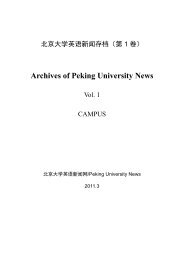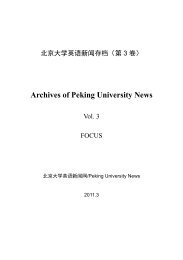Archives of Peking University News - PKU English - 北京大学
Archives of Peking University News - PKU English - 北京大学
Archives of Peking University News - PKU English - 北京大学
You also want an ePaper? Increase the reach of your titles
YUMPU automatically turns print PDFs into web optimized ePapers that Google loves.
<strong>北京大学</strong>英语新闻网/<strong>Peking</strong> <strong>University</strong> <strong>News</strong><br />
Liu Peng: Corporate social responsibility (CSR) refers to the expectations and<br />
requirements raised for corporations at a certain historical period <strong>of</strong> the economic<br />
and social development. In modern market economy, corporations are exercising<br />
greater influences on society and people‘s daily life, and playing a more important<br />
role in the economic and social development. Corporation is the creator <strong>of</strong> material<br />
and spiritual wealth while at the same time having impact on various fields: science,<br />
technology, education, culture, environment, etc. It has become a universal<br />
expectation and requirement <strong>of</strong> the modern society that corporations, as the<br />
converging point <strong>of</strong> different social agents, should shoulder more social<br />
responsibilities.<br />
In the early 20th century, the concept <strong>of</strong> ―corporate social responsibility‖ was<br />
proposed by some Western scholars, though merely within the academia. Then after<br />
the 1970s, with the rapid economic development in the West where there appeared<br />
severe environmental and social problems, CSR began to be noticed by the public<br />
and gained gradual recognition. The issue has received wider international attention<br />
since the beginning <strong>of</strong> the 21st century, when the economic globalization picks up a<br />
higher speed. With the help <strong>of</strong> governments, consumers‘ organizations, trade unions,<br />
environmental organizations and many other non-governmental organizations from<br />
Western countries, some <strong>of</strong> the multinational corporations set out to release social<br />
responsibility reports and formulate production codes as well as other principles,<br />
proposals and standards. In 2000, the United Nations initiated the ―Global Compact‖,<br />
advocating that enterprises should observe, support and implement within their<br />
influences a set <strong>of</strong> basic principles regarding human rights, labor standards,<br />
environment and anti-corruption, aimed at sustainable growth <strong>of</strong> corporations and<br />
shared augmentation in social benefits. In 2004, the International Organization for<br />
Standardization started to stipulate the Social Responsibility International Standards<br />
ISO 26000, which has received much attention and attracted active participation<br />
from the international community. About 80 countries and more than 300 specialists<br />
from different international organizations are taking part in this effort. Therefore, the<br />
CSR drive has already grown into a global fashion.<br />
Since the 1970s, overseas studies on CSR have entered a new stage. There are<br />
three most representative concepts proposed by scholars and organizations. The<br />
first is the ―Three Concentric Circles‖ as proposed by the Committee for Economic<br />
Development <strong>of</strong> the United States, which defines the ―inner circle‖ as essential<br />
responsibilities for corporations‘ economic functions, i.e. providing returns for<br />
investors, products for society, jobs for employees and contributing to economic<br />
growth. The ―middle circle‖ means that corporations‘ economic functions should<br />
conform to their social values and major social issues, e.g. environmental protection,<br />
fair treatment <strong>of</strong> employees, meeting customer‘s expectations, etc. Finally, the ―outer<br />
circle‖ is a wider range <strong>of</strong> intangible responsibilities to accelerate social<br />
advancement, e.g. social poverty elimination and urban decline prevention. The<br />
second concept is called the ―pyramid‖, brought forward by Pr<strong>of</strong>essor Carol <strong>of</strong><br />
542




